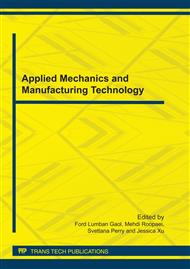[1]
Pusavec, F., Hamdi, H., Kopac, J. and Jawahir, I.S., Surface Integrity in Cryogenic Machining of Nickel Based Alloy—Inconel 718, J. Materials Processing Technology, Vol. 211, pp.773-783, (2011).
DOI: 10.1016/j.jmatprotec.2010.12.013
Google Scholar
[2]
Rafi, N.H. and Islam, M.N., An Investigation into Dimensional Accuracy and Surface Finish Achievable in Dry Turning, Machining Science and Technology, Vol. 13(4), pp.571-589, (2009).
DOI: 10.1080/10910340903451456
Google Scholar
[3]
Jayal, A.D. and Balaji, A.K., Effects of Cutting Fluid Application on Tool Wear in Machining: Interactions with Tool-coatings and Tool Surface Features, Wear, Vol. 269, pp.1723-1730, (2009).
DOI: 10.1016/j.wear.2009.06.032
Google Scholar
[4]
Marksberry, P.W. and Jawahir, I.S., A Comprehensive Tool-wear/Tool-life Model in the Evaluation of NDM (Near Dry Machining) for Sustainable Manufacturing, Int. J. Mach. Tools & Manuf., Vol. 48, pp.878-886, (2008).
DOI: 10.1016/j.ijmachtools.2007.11.006
Google Scholar
[5]
Lalwani D.I., Mehta N.K., and Jain P.K., Experimental Investigations of Cutting Parameters Influence on Cutting Forces and Surface Roughness in Finish Hard Turning of MDN250 Steel, J. Materials Processing Technology, Vol. 206, pp.167-179, (2008).
DOI: 10.1016/j.jmatprotec.2007.12.018
Google Scholar
[6]
Sreejith, P.S., Machining of 6061 Aluminum Alloy with MQL, Dry and Flooded Lubricant Conditions, Materials Letters, Vol. 62, pp.276-278, (2008).
DOI: 10.1016/j.matlet.2007.05.019
Google Scholar
[7]
Sarma, D.K. and Dixit, U.S., A Comparison of Dry and Air-cooled Turning of Grey Cast Iron with Mixed Oxide Ceramic Tool, J. Materials Processing Technology, Vol. 190, pp.160-172, (2007).
DOI: 10.1016/j.jmatprotec.2007.02.049
Google Scholar
[8]
Kamat, Y. and Obikawa, T., High Speed MQL Finish-turning of Inconel 718 with Different Coated Tools, J. Materials Processing Technology, Vol. 192-193, pp.281-286, (2007).
DOI: 10.1016/j.jmatprotec.2007.04.052
Google Scholar
[9]
Dhar, N.R., Ahmed, M.T. and Islam, S., An Experimental Investigation on Effect of Minimum Quality Lubrication in Machining AISI 1040 Steel, Int. J. Mach. Tools & Manuf., Vol. 47, pp.748-753, (2007).
DOI: 10.1016/j.ijmachtools.2006.09.017
Google Scholar
[10]
Bruni, C., Forcellese, F., Gabrielli, F. and Simoncini, M., Effect of the Lubrication-cooling Technique, Insert Technology and Machine Bed Material on the Workpart Surface Finish and Tool Wear in Finish Turning of AISI 420B, Int. J. Mach. Tools & Manuf., Vol. 46, pp.1547-1554, (2006).
DOI: 10.1016/j.ijmachtools.2005.09.007
Google Scholar
[11]
Dhar, N.R., Kamruzzaman, M. and Ahmed, M., Effect of Minimum Quantity Lubrication (MQL) on Tool Wear and Surface Roughness in Turning AISI-4340 Steel, J. Materials Processing Technology, Vol. 172, pp.299-304, (2006).
DOI: 10.1016/j.jmatprotec.2005.09.022
Google Scholar
[12]
Dilbag, S., and Rao, P.V., A Surface Roughness Prediction Model for Hard Turning Process, Int. J. Advanced Manufacturing Technology, Vol. 32, pp.1115-1124, (2006).
DOI: 10.1007/s00170-006-0429-2
Google Scholar
[13]
Varadaarajan, A.S., Philip, P.K. and Ramamoorthy, B., Investigations on Hard Turning with Minimal Cutting Fluid Application (HTMF) and its Comparison with Dry and Wet Turning, Int. J. Mach. Tools & Manuf., Vol. 42, pp.193-200, (2002).
DOI: 10.1016/s0890-6955(01)00119-5
Google Scholar
[14]
Australian Standard, AS2536 Surface Texture, Standards Association of Australia, (1982).
Google Scholar
[15]
Park, S.H., Robust Design and Analysis for Quality Engineering, Chapman & Hall, London, (1996).
Google Scholar
[16]
Ross, P.J., Taguchi Techniques for Quality Engineering, McGraw-Hill, New York, (1988).
Google Scholar
[17]
Taguchi, G., System of Experimental Design: Engineering Methods to Optimize Quality and Minimize Cost, Vol. 2, UNIPUB/Kraus Int. Pub., White Plains, NY, (1987).
Google Scholar
[18]
MatWeb, Material Property Data, Accessed through Internet (3/3/2011), http: /www. matweb. com.
Google Scholar
[19]
Lima, J.G., Avila, R.F., Abrao, A.M., Faustino, M. and Davim, J.P., Hard Turning: AISI 4340 High Strength low Alloy Steel and AISI D2 Cold Work Tool Steel, J. of Materials Processing Technology, Vol. 169, 388-395, (2005).
DOI: 10.1016/j.jmatprotec.2005.04.082
Google Scholar
[20]
Davim, J.P., A Note on the Determination of Optimal Cutting Conditions for Surface Finish Obtained in Turning Using Design of Experiments, Journal of Materials Processing Technology, Vol. 116, pp.305-308, (2001).
DOI: 10.1016/s0924-0136(01)01063-9
Google Scholar
[21]
Rafai, N.H. and Islam M.N., Comparison of Dry and Flood Turning in Terms of Quality of Turned Parts, Proc. World Congress on Engineering 2010, June 30th–July 2nd, 2010, London, p.2044-(2049).
Google Scholar
[22]
Islam M.N. and Brian Boswell, An Investigation of Surface Finish in Dry Turning, in press, World Congress on Engineering 2011, July 6th– 8th, 2011, London.
Google Scholar


